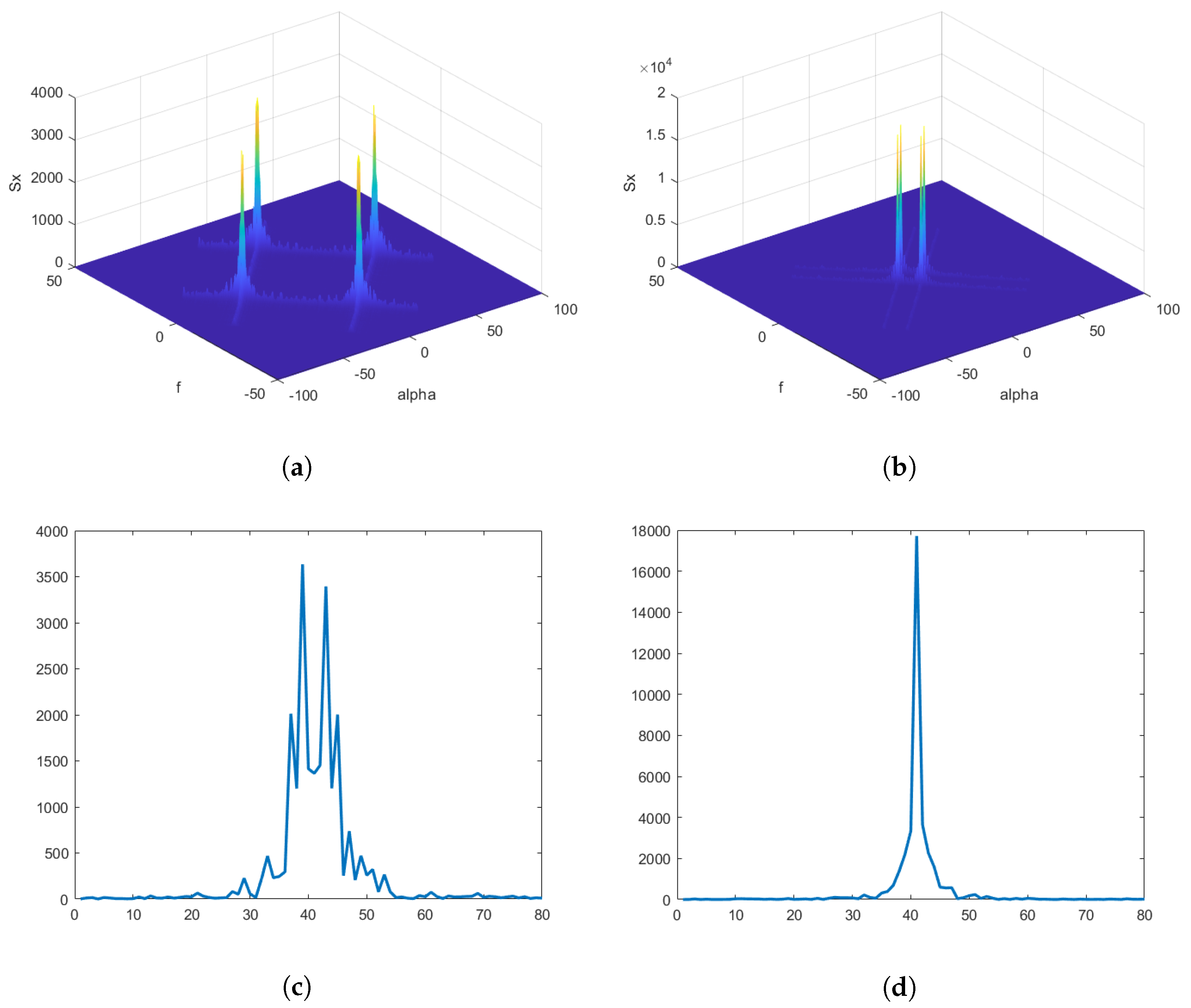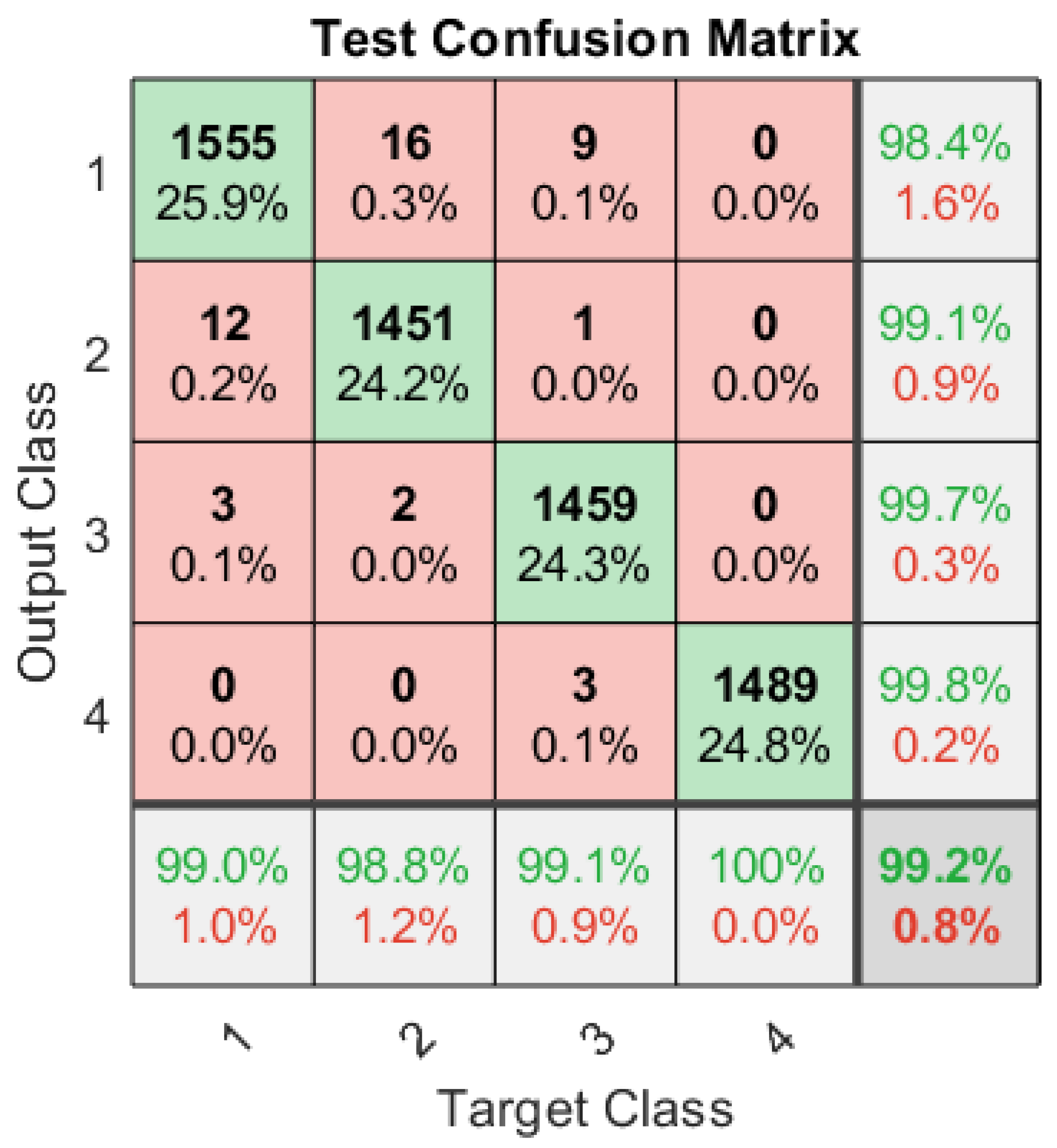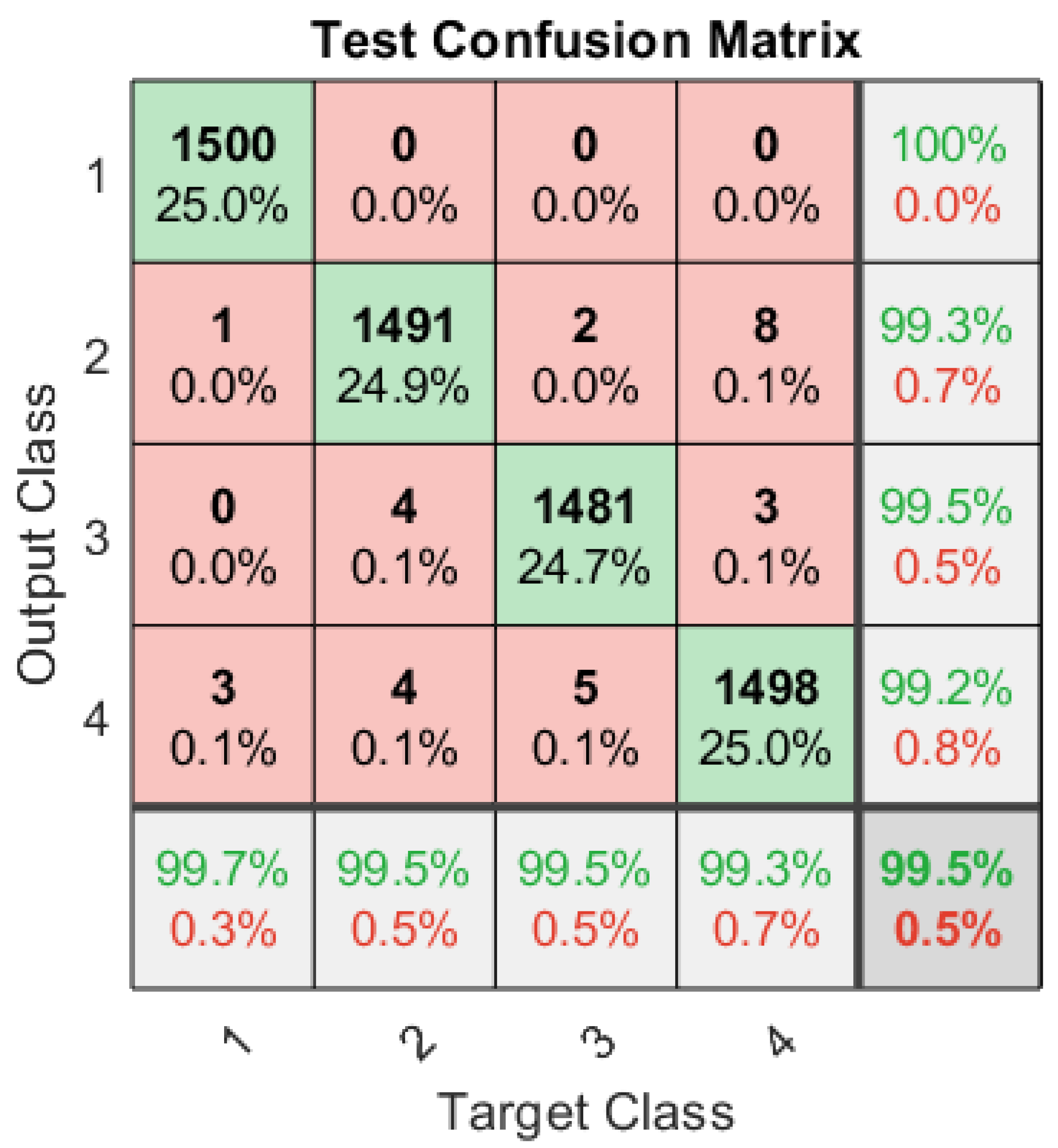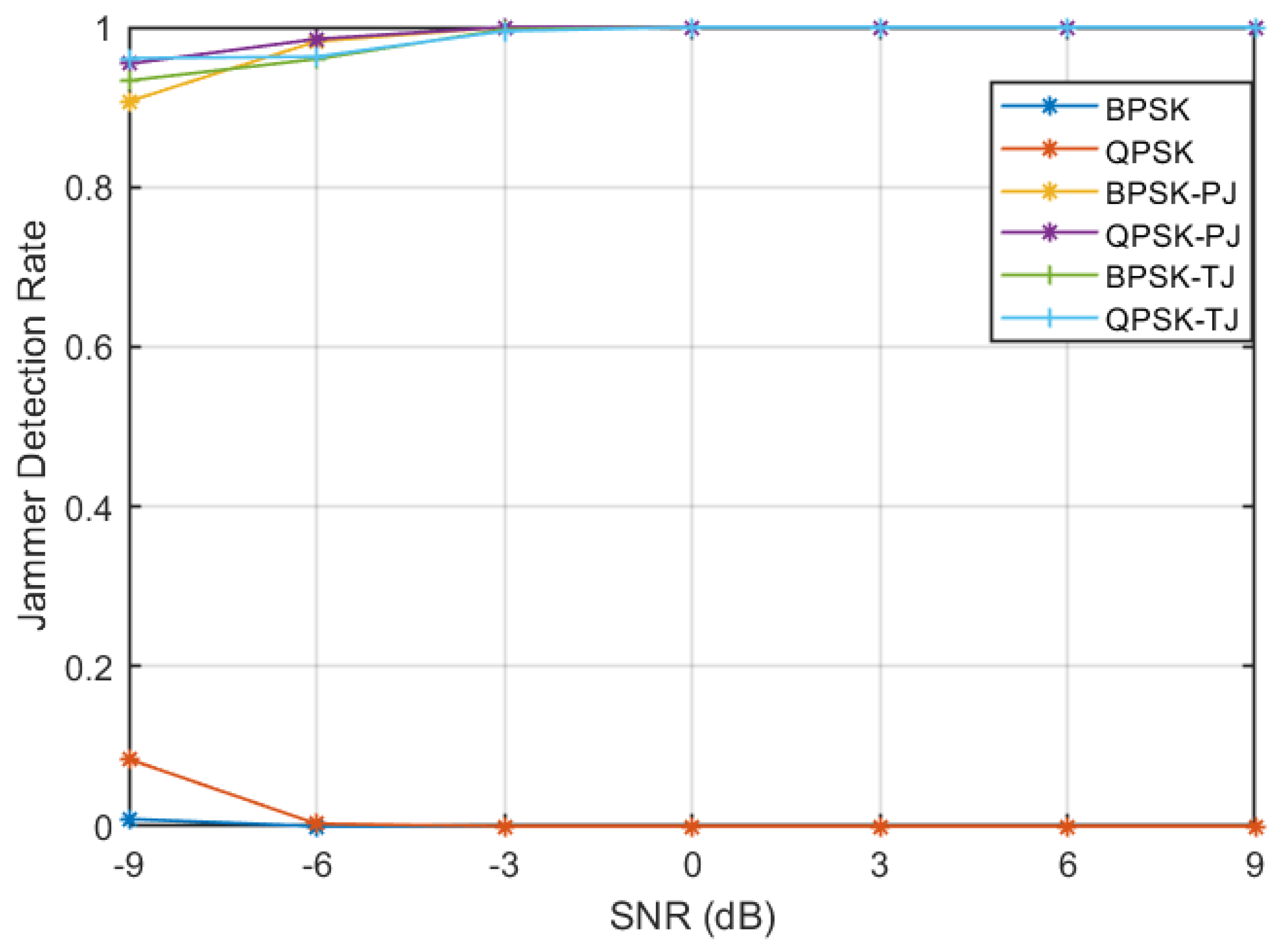Machine-Learning-Assisted Cyclostationary Spectral Analysis for Joint Signal Classification and Jammer Detection at the Physical Layer of Cognitive Radio
Abstract
1. Introduction
- Classify received licit signals into their corresponding modulation schemes using CFD and artificial neural network;
- Detect both multi-tone and modulated pulsed stealthy jammers using the CFD and the same trained artificial neural network classifier as above.
2. System Model and Problem Formulation
- Jammer is equipped with ED sensing technique and uses multi-tone as the jamming strategy to jam multiple NB signals in the observed WB signal. A tone with sufficiently higher power than the licit signal can jam any of the occupied SBs as shown in Figure 1.
- Jammer is equipped with a feature detector; hence, it is able to recognise the modulation schemes of transmitted signals and, therefore, uses the optimal pulsed (modulated) jamming schemes against the target signals, as shown in Figure 1.
- -
- No jamming: jammer is not transmitting
- -
- Tone jamming: jammer employs multi-tone to jam the NB signals in WB spectrum
- -
- Pulsed jamming: jammer employs pulsed jamming to jam the NB signals in WB spectrum. We used the MatLab environment to simulate the system model according to the specifications provided above.
3. Proposed Algorithm
3.1. Cyclostationary Spectral Analysis
3.2. Artificial Neural Network and Proposed Algorithm
| Algorithm 1 Pseudo-code for proposed algorithm |
| 1: function Joint Signal Classification and Stealthy Jammer Detection 2: Input: 3: Train → Train ANN with Labelled data set 4: Test → Independent data set 5: Output: 6: Predicted → Signal class 7: Procedure: 8: Initialise all SB states to “free” 9: Receive the WB signal 10: Divide WB into j SBs 11: for , do 12: Compute the SCF of each NB signal 13: Obtain the and f-profiles from SCF 14: Feed the concatenated and f frequency profiles for to previously trained ANN 15: Decision ← Signal class 16: end for 17: end function |
4. Simulation Results and Discussion
4.1. Dedicated ANN Architecture for the Stealthy Jamming Attacks
4.2. A Single ANN Architecture for Both Stealthy Jamming Attacks
5. Conclusions
Author Contributions
Funding
Institutional Review Board Statement
Informed Consent Statement
Data Availability Statement
Acknowledgments
Conflicts of Interest
References
- Nasser, A.; Al Haj Hassan, H.; Abou Chaaya, J.; Mansour, A.; Yao, K.C. Spectrum Sensing for Cognitive Radio: Recent Advances and Future Challenge. Sensors 2021, 21, 2408. [Google Scholar] [CrossRef] [PubMed]
- Haykin, S. Cognitive dynamic systems: Radar, control, and radio [point of view]. Proc. IEEE 2012, 100, 2095–2103. [Google Scholar] [CrossRef]
- Arjoune, Y.; Kaabouch, N. A Comprehensive Survey on Spectrum Sensing in Cognitive Radio Networks: Recent Advances, New Challenges, and Future Research Directions. Sensors 2019, 19, 126. [Google Scholar] [CrossRef] [PubMed]
- Haykin, S. Cognitive radio: Brain-empowered wireless communications. IEEE J. Sel. Areas Commun. 2005, 23, 201–220. [Google Scholar] [CrossRef]
- Holland, O.; Ping, S.; Aijaz, A.; Chareau, J.M.; Chawdhry, P.; Gao, Y.; Qin, Z.; Kokkinen, H. To white space or not to white space: That is the trial within the Ofcom TV white spaces pilot. In Proceedings of the 2015 IEEE International Symposium on Dynamic Spectrum Access Networks (DySPAN), Stockholm, Sweden, 29 September–2 October 2015; pp. 11–22. [Google Scholar]
- Qin, Z.; Gao, Y.; Parini, C.G. Data-assisted low complexity compressive spectrum sensing on real-time signals under sub-Nyquist rate. IEEE Trans. Wirel. Commun. 2015, 15, 1174–1185. [Google Scholar] [CrossRef]
- Qin, Z.; Gao, Y.; Plumbley, M.D.; Parini, C.G. Wideband spectrum sensing on real-time signals at sub-Nyquist sampling rates in single and cooperative multiple nodes. IEEE Trans. Signal Process. 2015, 64, 3106–3117. [Google Scholar] [CrossRef]
- Ma, Y.; Gao, Y.; Liang, Y.C.; Cui, S. Reliable and efficient sub-Nyquist wideband spectrum sensing in cooperative cognitive radio networks. IEEE J. Sel. Areas Commun. 2016, 34, 2750–2762. [Google Scholar] [CrossRef]
- Martin, J.H.; Dooley, L.S.; Wong, K.C.P. New dynamic spectrum access algorithm for TV white space cognitive radio networks. IET Commun. 2016, 10, 2591–2597. [Google Scholar] [CrossRef]
- Lin, S.; Kong, L.; Gao, Q.; Khan, M.K.; Zhong, Z.; Jin, X.; Zeng, P. Advanced dynamic channel access strategy in spectrum sharing 5G systems. IEEE Wirel. Commun. 2017, 24, 74–80. [Google Scholar] [CrossRef]
- Dabcevic, K.; Betancourt, A.; Marcenaro, L.; Regazzoni, C.S. Intelligent cognitive radio jamming—A game-theoretical approach. EURASIP J. Adv. Signal Process. 2014, 2014, 171. [Google Scholar] [CrossRef]
- Dabcevic, K.; Mughal, M.O.; Marcenaro, L.; Regazzoni, C.S. Cognitive Radio as the Facilitator for Advanced Communications Electronic Warfare Solutions. J. Signal Process. Syst. 2015, 83, 29–44. [Google Scholar] [CrossRef]
- Krayani, A.; William, N.J.; Marcenaro, L.; Regazzoni, C. Jammer Detection in Vehicular V2X Networks. In Proceedings of the 2022 Microwave Mediterranean Symposium (MMS), Pizzo Calabro, Italy, 11–12 May 2022; pp. 1–5. [Google Scholar] [CrossRef]
- Barb, G.; Alexa, F.; Otesteanu, M. Dynamic Spectrum Sharing for Future LTE-NR Networks. Sensors 2021, 21, 4215. [Google Scholar] [CrossRef] [PubMed]
- Moon, B. Dynamic Spectrum Access for Internet of Things Service in Cognitive Radio-Enabled LPWANs. Sensors 2017, 17, 2818. [Google Scholar] [CrossRef] [PubMed]
- Lin, R.; Qiu, H.; Jiang, W.; Jiang, Z.; Li, Z.; Wang, J. Deep Reinforcement Learning for Physical Layer Security Enhancement in Energy Harvesting Based Cognitive Radio Networks. Sensors 2023, 23, 807. [Google Scholar] [CrossRef] [PubMed]
- Gao, Y.; Qin, Z.; Feng, Z.; Zhang, Q.; Holland, O.; Dohler, M. Scalable and reliable IoT enabled by dynamic spectrum management for M2M in LTE-A. IEEE Internet Things J. 2016, 3, 1135–1145. [Google Scholar] [CrossRef]
- Fiaschetti, A.; Noll, J.; Azzoni, P.; Uribeetxeberria, R. Measurable and Composable Security, Privacy, and Dependability for Cyberphysical Systems: The SHIELD Methodology; CRC Press: Boca Raton, FL, USA, 2017. [Google Scholar]
- Mohammadi, J.; Stańczak, S.; Zheng, M. Joint spectrum sensing and jamming detection with correlated channels in cognitive radio networks. In Proceedings of the 2015 IEEE International Conference on Communication Workshop (ICCW), London, UK, 8–12 June 2015; pp. 889–894. [Google Scholar]
- Rahman, M.J.A.; Krunz, M.; Erwin, R. Interference mitigation using spectrum sensing and dynamic frequency hopping. In Proceedings of the 2012 IEEE International Conference on Communications (ICC), Ottawa, ON, Canada, 10–15 June 2012; pp. 4421–4425. [Google Scholar]
- Chin, W.L.; Li, J.M.; Chen, H.H. Low-complexity energy detection for spectrum sensing with random arrivals of primary users. IEEE Trans. Veh. Technol. 2015, 65, 947–952. [Google Scholar] [CrossRef]
- Kozłowski, S. Implementation and verification of cyclostationary feature detector for DVB-T signals. IET Signal Process. 2016, 10, 162–167. [Google Scholar] [CrossRef]
- Zhang, X.; Gao, F.; Chai, R.; Jiang, T. Matched filter based spectrum sensing when primary user has multiple power levels. China Commun. 2015, 12, 21–31. [Google Scholar] [CrossRef]
- Gardner, W.; Spooner, C. The cumulant theory of cyclostationary time-series. I. Foundation. IEEE Trans. Signal Process. 1994, 42, 3387–3408. [Google Scholar] [CrossRef]
- Roberts, R.S.; Brown, W.A.; Loomis, H.H. Computationally efficient algorithms for cyclic spectral analysis. IEEE Signal Process. Mag. 1991, 8, 38–49. [Google Scholar] [CrossRef]
- Spooner, C.; Gardner, W. The cumulant theory of cyclostationary time-series. II. Development and applications. IEEE Trans. Signal Process. 1994, 42, 3409–3429. [Google Scholar] [CrossRef]
- Wu, Z.; Like, E.; Chakravarthy, V. Reliable modulation classification at low SNR using spectral correlation. In Proceedings of the 2007 4th IEEE Consumer Communications and Networking Conference, Las Vegas, NV, USA, 11–13 January 2007; pp. 1134–1138. [Google Scholar]
- Al-Habashna, A.; Dobre, O.A.; Venkatesan, R.; Popescu, D.C. Second-Order Cyclostationarity of Mobile WiMAX and LTE OFDM Signals and Application to Spectrum Awareness in Cognitive Radio Systems. IEEE J. Sel. Top. Signal Process. 2012, 6, 26–42. [Google Scholar] [CrossRef]
- Like, E.; Chakravarthy, V.; Husnay, R.; Wu, Z. Modulation recognition in multipath fading channels using cyclic spectral analysis. In Proceedings of the IEEE GLOBECOM 2008—2008 IEEE Global Telecommunications Conference, New Orleans, LA, USA, 30 November–4 December 2008; pp. 1–6. [Google Scholar]
- Yucek, T.; Arslan, H. A survey of spectrum sensing algorithms for cognitive radio applications. IEEE Commun. Surv. Tutor. 2009, 11, 116–130. [Google Scholar] [CrossRef]
- Nawaz, T.; Campo, D.; Mughal, M.O.; Marcenaro, L.; Regazzoni, C.S. Jammer Detection Algorithm for Wide-band Radios using Spectral Correlation and Neural Networks. In Proceedings of the 13th International Conference on Wireless Communications and Mobile Computing, Valencia, Spain, 26–30 June 2017; Volume 1, pp. 890–897. [Google Scholar]
- Nawaz, T.; Marcenaro, L.; Regazzoni, C.S. Stealthy jammer detection algorithm for wide-band radios: A physical layer approach. In Proceedings of the 2017 IEEE 13th International Conference on Wireless and Mobile Computing, Networking and Communications (WiMob), Rome, Italy, 9–11 October 2017; pp. 79–83. [Google Scholar] [CrossRef]
- Alfaqawi, M.I.; Chebil, J.; Habaebi, M.H.; Datla, D. Wireless distributed computing for cyclostationary feature detection. Digit. Commun. Netw. 2016, 2, 47–56. [Google Scholar] [CrossRef]
- Chen, R.; Park, J.M.; Reed, J.H. Defense against Primary User Emulation Attacks in Cognitive Radio Networks. IEEE J. Sel. Areas Commun. 2008, 26, 25–37. [Google Scholar] [CrossRef]
- Wang, L.; Wyglinski, A.M. A combined approach for distinguishing different types of jamming attacks against wireless networks. In Proceedings of the 2011 IEEE Pacific Rim Conference on Communications, Computers and Signal Processing, Victoria, BC, Canada, 23–26 August 2011; pp. 809–814. [Google Scholar]
- Pelechrinis, K.; Iliofotou, M.; Krishnamurthy, S.V. Denial of Service Attacks in Wireless Networks: The Case of Jammers. IEEE Commun. Surv. Tutor. 2011, 13, 245–257. [Google Scholar] [CrossRef]
- Poiselr, R.A. Introduction to Communication Electronic Warfare Systems. In Proceedings of the 2014 IEEE Global Communications Conference, Austin, TX, USA, 8–12 December 2014. [Google Scholar]
- Qian, L.; Li, X.; Wei, S. Anomaly Spectrum Usage Detection in Multihop Cognitive Radio Networks: A Cross-Layer Approach. JCM 2013, 8, 259–266. [Google Scholar] [CrossRef]
- Amuru, S.; Buehrer, R.M. Optimal jamming strategies in digital communications-Impact of modulation. In Proceedings of the 2014 IEEE Global Communications Conference, Austin, TX, USA, 8–12 December 2014; pp. 1619–1624. [Google Scholar]
- Amuru, S.; Buehrer, R.M. Optimal Jamming Against Digital Modulation. IEEE Trans. Inf. Forensics Secur. 2015, 10, 2212–2224. [Google Scholar] [CrossRef]
- Moser, E.; Moran, M.K.; Hillen, E.; Li, D.; Wu, Z. Automatic modulation classification via instantaneous features. In Proceedings of the 2015 National Aerospace and Electronics Conference (NAECON), Dayton, OH, USA, 15–19 June 2015; pp. 218–223. [Google Scholar]
- Gardner, W.A. Signal interception: A unifying theoretical framework for feature detection. IEEE Trans. Commun. 1988, 36, 897–906. [Google Scholar] [CrossRef]
- Møller, M.F. A scaled conjugate gradient algorithm for fast supervised learning. Neural Netw. 1993, 6, 525–533. [Google Scholar] [CrossRef]
- Lee, S.H.; Kim, K.Y.; Shin, Y. Effective Feature Selection Method for Deep Learning-Based Automatic Modulation Classification Scheme Using Higher-Order Statistics. Appl. Sci. 2020, 10, 588. [Google Scholar] [CrossRef]
- Mughal, M.O.; Kim, S. Signal Classification and Jamming Detection in Wide-Band Radios Using Naïve Bayes Classifier. IEEE Commun. Lett. 2018, 22, 1398–1401. [Google Scholar] [CrossRef]
- Hameed, F.; Dobre, O.A.; Popescu, D.C. On the likelihood-based approach to modulation classification. IEEE Trans. Wirel. Commun. 2009, 8, 5884–5892. [Google Scholar] [CrossRef]
- Shi, W.; Liu, D.; Cheng, X.; Li, Y.; Zhao, Y. Particle Swarm Optimization-Based Deep Neural Network for Digital Modulation Recognition. IEEE Access 2019, 7, 104591–104600. [Google Scholar] [CrossRef]
- Hu, S.; Pei, Y.; Liang, P.P.; Liang, Y.C. Deep neural network for robust modulation classification under uncertain noise conditions. IEEE Trans. Veh. Technol. 2019, 69, 564–577. [Google Scholar] [CrossRef]
- Zhang, X.; Ge, T.; Chen, Z. Automatic Modulation Recognition of Communication Signals Based on Instantaneous Statistical Characteristics and SVM Classifier. In Proceedings of the 2018 IEEE Asia-Pacific Conference on Antennas and Propagation (APCAP), Auckland, New Zealand, 5–8 August 2018; pp. 344–346. [Google Scholar] [CrossRef]









| Signal Class | BPSK | QPSK | BPSK-TJammed | QPSK-TJammed |
|---|---|---|---|---|
| BPSK | 977 | 21 | 2 | 0 |
| QPSK | 33 | 967 | 0 | 0 |
| BPSK-TJammed | 2 | 3 | 987 | 8 |
| QPSK-TJammed | 0 | 0 | 8 | 992 |
| Signal Class | BPSK | QPSK | BPSK-TJammed | QPSK-TJammed |
|---|---|---|---|---|
| BPSK | 990 | 10 | 0 | 0 |
| QPSK | 13 | 985 | 0 | 3 |
| BPSK-TJammed | 0 | 0 | 992 | 8 |
| QPSK-TJammed | 0 | 0 | 2 | 998 |
| Signal Class | BPSK | QPSK | BPSK-TJammed | QPSK-TJammed |
|---|---|---|---|---|
| BPSK | 1000 | 0 | 0 | 0 |
| QPSK | 0 | 1000 | 0 | 0 |
| BPSK-TJammed | 0 | 0 | 1000 | 0 |
| QPSK-TJammed | 0 | 0 | 0 | 1000 |
| Signal Class | BPSK | QPSK | BPSK-TJammed | QPSK-TJammed |
|---|---|---|---|---|
| BPSK | 1000 | 0 | 0 | 0 |
| QPSK | 0 | 1000 | 0 | 0 |
| BPSK-TJammed | 0 | 0 | 1000 | 0 |
| QPSK-TJammed | 0 | 0 | 0 | 1000 |
| Signal Class | BPSK | QPSK | BPSK-TJammed | QPSK-TJammed |
|---|---|---|---|---|
| BPSK | 1000 | 0 | 0 | 0 |
| QPSK | 0 | 1000 | 0 | 0 |
| BPSK-TJammed | 0 | 0 | 1000 | 0 |
| QPSK-TJammed | 0 | 0 | 0 | 1000 |
| Signal Class | BPSK | QPSK | BPSK-TJammed | QPSK-TJammed |
|---|---|---|---|---|
| BPSK | 1000 | 0 | 0 | 0 |
| QPSK | 0 | 1000 | 0 | 0 |
| BPSK-TJammed | 0 | 0 | 1000 | 0 |
| QPSK-TJammed | 0 | 0 | 0 | 1000 |
| Signal Class | BPSK | QPSK | BPSK-PJammed | QPSK-PJammed |
|---|---|---|---|---|
| BPSK | 990 | 5 | 3 | 2 |
| QPSK | 3 | 988 | 2 | 7 |
| BPSK-PJammed | 0 | 0 | 992 | 8 |
| QPSK-PJammed | 0 | 0 | 5 | 995 |
| Signal Class | BPSK | QPSK | BPSK-PJammed | QPSK-PJammed |
|---|---|---|---|---|
| BPSK | 990 | 10 | 0 | 0 |
| QPSK | 13 | 985 | 0 | 3 |
| BPSK-PJammed | 0 | 0 | 992 | 8 |
| QPSK-PJammed | 0 | 0 | 2 | 998 |
| Signal Class | BPSK | QPSK | BPSK-PJammed | QPSK-PJammed |
|---|---|---|---|---|
| BPSK | 1000 | 0 | 0 | 0 |
| QPSK | 0 | 1000 | 0 | 0 |
| BPSK-PJammed | 0 | 0 | 1000 | 0 |
| QPSK-PJammed | 0 | 0 | 0 | 1000 |
| Signal Class | BPSK | QPSK | BPSK-PJammed | QPSK-PJammed |
|---|---|---|---|---|
| BPSK | 1000 | 0 | 0 | 0 |
| QPSK | 0 | 1000 | 0 | 0 |
| BPSK-PJammed | 0 | 0 | 1000 | 0 |
| QPSK-PJammed | 0 | 0 | 0 | 1000 |
| Signal Class | BPSK | QPSK | BPSK-PJammed | QPSK-PJammed |
|---|---|---|---|---|
| BPSK | 1000 | 0 | 0 | 0 |
| QPSK | 0 | 1000 | 0 | 0 |
| BPSK-PJammed | 0 | 0 | 1000 | 0 |
| QPSK-PJammed | 0 | 0 | 0 | 1000 |
| Signal Class | BPSK | QPSK | BPSK-PJammed | QPSK-PJammed |
|---|---|---|---|---|
| BPSK | 1000 | 0 | 0 | 0 |
| QPSK | 0 | 1000 | 0 | 0 |
| BPSK-PJammed | 0 | 0 | 1000 | 0 |
| QPSK-PJammed | 0 | 0 | 0 | 1000 |
| Signal Class | BPSK | QPSK | BPSK-PJ | QPSK-PJ | BPSK-TJ | QPSK-TJ |
|---|---|---|---|---|---|---|
| BPSK | 968 | 23 | 9 | 0 | 0 | 0 |
| QPSK | 2 | 914 | 15 | 1 | 1 | 67 |
| BPSK-PJ | 9 | 7 | 907 | 1 | 71 | 5 |
| QPSK-PJ | 0 | 0 | 2 | 954 | 1 | 43 |
| BPSK-TJ | 0 | 0 | 48 | 5 | 933 | 14 |
| QPSK-TJ | 0 | 3 | 0 | 23 | 13 | 961 |
| Signal Class | BPSK | QPSK | BPSK-PJ | QPSK-PJ | BPSK-TJ | QPSK-TJ |
|---|---|---|---|---|---|---|
| BPSK | 980 | 20 | 0 | 0 | 0 | 0 |
| QPSK | 13 | 984 | 3 | 0 | 0 | 0 |
| BPSK-PJ | 0 | 1 | 982 | 10 | 7 | 0 |
| QPSK-PJ | 0 | 0 | 0 | 985 | 1 | 14 |
| BPSK-TJ | 0 | 0 | 35 | 5 | 960 | 0 |
| QPSK-TJ | 0 | 9 | 0 | 25 | 3 | 963 |
| Signal Class | BPSK | QPSK | BPSK-PJ | QPSK-PJ | BPSK-TJ | QPSK-TJ |
|---|---|---|---|---|---|---|
| BPSK | 999 | 1 | 0 | 0 | 0 | 0 |
| QPSK | 2 | 998 | 0 | 0 | 0 | 0 |
| BPSK-PJ | 0 | 0 | 1000 | 0 | 0 | 0 |
| QPSK-PJ | 0 | 0 | 0 | 1000 | 0 | 0 |
| BPSK-TJ | 0 | 0 | 0 | 3 | 997 | 0 |
| QPSK-TJ | 0 | 0 | 0 | 5 | 0 | 995 |
| Signal Class | BPSK | QPSK | BPSK-PJ | QPSK-PJ | BPSK-TJ | QPSK-TJ |
|---|---|---|---|---|---|---|
| BPSK | 1000 | 0 | 0 | 0 | 0 | 0 |
| QPSK | 0 | 1000 | 0 | 0 | 0 | 0 |
| BPSK-PJ | 0 | 0 | 1000 | 0 | 0 | 0 |
| QPSK-PJ | 0 | 0 | 0 | 1000 | 0 | 0 |
| BPSK-TJ | 0 | 0 | 0 | 0 | 1000 | 0 |
| QPSK-TJ | 0 | 0 | 0 | 0 | 0 | 1000 |
| Signal Class | BPSK | QPSK | BPSK-PJ | QPSK-PJ | BPSK-TJ | QPSK-TJ |
|---|---|---|---|---|---|---|
| BPSK | 1000 | 0 | 0 | 0 | 0 | 0 |
| QPSK | 0 | 1000 | 0 | 0 | 0 | 0 |
| BPSK-PJ | 0 | 0 | 1000 | 0 | 0 | 0 |
| QPSK-PJ | 0 | 0 | 0 | 1000 | 0 | 0 |
| BPSK-TJ | 0 | 0 | 0 | 0 | 1000 | 0 |
| QPSK-TJ | 0 | 0 | 0 | 0 | 0 | 1000 |
| Signal Class | BPSK | QPSK | BPSK-PJ | QPSK-PJ | BPSK-TJ | QPSK-TJ |
|---|---|---|---|---|---|---|
| BPSK | 1000 | 0 | 0 | 0 | 0 | 0 |
| QPSK | 0 | 1000 | 0 | 0 | 0 | 0 |
| BPSK-PJ | 0 | 0 | 1000 | 0 | 0 | 0 |
| QPSK-PJ | 0 | 0 | 0 | 1000 | 0 | 0 |
| BPSK-TJ | 0 | 0 | 0 | 0 | 1000 | 0 |
| QPSK-TJ | 0 | 0 | 0 | 0 | 0 | 1000 |
Disclaimer/Publisher’s Note: The statements, opinions and data contained in all publications are solely those of the individual author(s) and contributor(s) and not of MDPI and/or the editor(s). MDPI and/or the editor(s) disclaim responsibility for any injury to people or property resulting from any ideas, methods, instructions or products referred to in the content. |
© 2023 by the authors. Licensee MDPI, Basel, Switzerland. This article is an open access article distributed under the terms and conditions of the Creative Commons Attribution (CC BY) license (https://creativecommons.org/licenses/by/4.0/).
Share and Cite
Nawaz, T.; Alzahrani, A. Machine-Learning-Assisted Cyclostationary Spectral Analysis for Joint Signal Classification and Jammer Detection at the Physical Layer of Cognitive Radio. Sensors 2023, 23, 7144. https://doi.org/10.3390/s23167144
Nawaz T, Alzahrani A. Machine-Learning-Assisted Cyclostationary Spectral Analysis for Joint Signal Classification and Jammer Detection at the Physical Layer of Cognitive Radio. Sensors. 2023; 23(16):7144. https://doi.org/10.3390/s23167144
Chicago/Turabian StyleNawaz, Tassadaq, and Ali Alzahrani. 2023. "Machine-Learning-Assisted Cyclostationary Spectral Analysis for Joint Signal Classification and Jammer Detection at the Physical Layer of Cognitive Radio" Sensors 23, no. 16: 7144. https://doi.org/10.3390/s23167144
APA StyleNawaz, T., & Alzahrani, A. (2023). Machine-Learning-Assisted Cyclostationary Spectral Analysis for Joint Signal Classification and Jammer Detection at the Physical Layer of Cognitive Radio. Sensors, 23(16), 7144. https://doi.org/10.3390/s23167144






